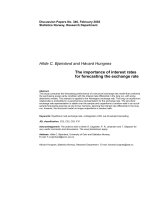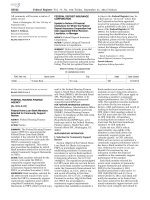Undress for success the naked truth about making money at home
Bạn đang xem bản rút gọn của tài liệu. Xem và tải ngay bản đầy đủ của tài liệu tại đây (2.88 MB, 291 trang )
UNDRESS
FOR
SUCCESS
The Naked Truth About
Making Money at Home
Kate Lister
Tom Harnish
Foreword by Jack Nilles, internationally
acclaimed telework authority
John Wiley & Sons, Inc.
Praise for Undress for Success
‘‘The best collection of teleworking ‘How-To’s’ and ‘Why’s’ that I’ve seen
anywhere. This book is a gold mine for anyone seriously considering
working from home. Whether you want to freelance, operate your own
business, or stay fully employed while you work at home, you’ll find dozens
of hints and insights in this wonderfully entertaining and insightful book.
And if you’re an employer who wants to attract and retain talented people,
give them a copy of this book, send them home, and reap the benefits of their
productivity and motivation. They’ll love you for enhancing their lives.’’
—Jim Ware, cofounder, Future of Work Program
‘‘No one should attempt e-work until they understand how to be a
competent e-worker. This unique and enlightening guide will help you
open the door to e-work success—and improve every aspect of your life in
the process.’’
—Marcia Rhodes, Public Relations Director, WorldatWork
‘‘There’s never been a comprehensive guide to all aspects of telecommuting, until Undress for Success. Whether you want to work remotely occasionally in your current job, find a full-time ework job, or start a business
that allows you to work from or at home, Lister and Harnish cover all of
the bases in this comprehensive, easy-to-read guide that clearly outlines
the rules of success.’’
—Cali Williams Yost, Fast Company expert and author,
Work+Life: Finding the Fit That’s Right for You
‘‘Undress for Success offers the perfect balance between covering all the
details and doing so in an easy-to-read and light-hearted way.’’
—Bob Fortier, President of InnoVisions Canada,
and The Canadian Telework Association
‘‘I wish I’d had this book when I first started out—it’s like having your own
personal career coach. Reading this will save many new freelancers a lot of
grief!’’
—Allena Tapia, About.com: Freelance Writing Guide and
Editor of Garden Wall Publications
‘‘If you’re an old-fashioned manager who’s obsessed with face time, hide
this book now. There is no way your employees will commute to their
cubicles Monday morning after reading this entertaining manifesto for
ditching the panty hose and actually enjoying work.’’
—Laura Vanderkam, author, Grindhopping: Build a
Rewarding Career Without Paying Your Dues
‘‘You could spend years with focus groups, assemble cross-functional
internal teams to study and recommend organizational changes, or simply
read Undress for Success to obtain the practical knowledge necessary to
better serve your customers; increase loyalty and productivity; avoid
layoffs; and improve your profitability for whatever comes your way.
Kate and Tom are the ‘guiding hands’ for self-reliant control of your
future success from home!’’
—Jack Heacock, SVP and cofounder of The
Telework Coalition, Washington, D.C.
UNDRESS FOR
SUCCESS
UNDRESS
FOR
SUCCESS
The Naked Truth About
Making Money at Home
Kate Lister
Tom Harnish
Foreword by Jack Nilles, internationally
acclaimed telework authority
John Wiley & Sons, Inc.
Copyright # 2009 by Kate Lister and Tom Harnish. All rights reserved.
Published by John Wiley & Sons, Inc., Hoboken, New Jersey
Published simultaneously in Canada
No part of this publication may be reproduced, stored in a retrieval system, or transmitted in any
form or by any means, electronic, mechanical, photocopying, recording, scanning, or otherwise,
except as permitted under Section 107 or 108 of the 1976 United States Copyright Act, without
either the prior written permission of the Publisher, or authorization through payment of the
appropriate per-copy fee to the Copyright Clearance Center, Inc., 222 Rosewood Drive, Danvers,
MA 01923, (978) 750-8400, fax (978) 646-8600, or on the web at www.copyright.com. Requests to
the Publisher for permission should be addressed to the Permissions Department, John Wiley &
Sons, Inc., 111 River Street, Hoboken, NJ 07030, (201) 748-6011, fax (201) 748-6008, or online at
/>Limit of Liability/Disclaimer of Warranty: While the publisher and author have used their best
efforts in preparing this book, they make no representations or warranties with respect to the
accuracy or completeness of the contents of this book and specifically disclaim any implied warranties
of merchantability or fitness for a particular purpose. No warranty may be created or extended by
sales representatives or written sales materials. The advice and strategies contained herein may not be
suitable for your situation. You should consult with a professional where appropriate. Neither the
publisher nor author shall be liable for any loss of profit or any other commercial damages, including
but not limited to special, incidental, consequential, or other damages.
For general information on our other products and services or for technical support, please contact
our Customer Care Department within the United States at (800) 762-2974, outside the United
States at (317) 572-3993 or fax (317) 572-4002.
Wiley also publishes its books in a variety of electronic formats. Some content that appears in print
may not be available in electronic books. For more information about Wiley products, visit our web
site at www.wiley.com
Library of Congress Cataloging-in-Publication Data:
Lister, Kate, 1959Undress for success : the naked truth about making money at home / Kate Lister, Tom Harnish.
p. cm.
Includes bibliographical references and index.
ISBN 978-0-470-38332-2 (cloth)
1. Telecommuting. 2. Virtual work teams. 3. Home labor. I. Harnish, Tom, 1945II. Title.
HD2336.3.L57 2009
2008054164
331.25 0 68–dc22
Printed in the United States of America
10 9 8 7 6 5 4 3 2 1
For Gretchen
Contents
Foreword
Jack Nilles
xiii
Acknowledgments
xvii
Introduction
xxi
1 E-work, The Bare Essentials
1
1 Who E-works and What Do They Do?
3
2 What’s in It for Me?
7
3 Expose Yourself—Are You Right for E-work?
12
4 Dirty Underwear—Uncovering the Scams
21
2 Pajama Paychecks:
Jobs You Can Do in Your Jammies
31
5 Who’s Paid to Work at Home and
What Do They Do?
33
6 Take Your Job and Love It
35
7 The Naked Truth about Your Boss
38
8 What’s in It for Your Employer?
44
9 Making Your E-work Pitch
55
10 Best-Bet E-work Employers
59
11 Work as a Call Center Agent
63
12 Work as a Virtual Assistant
73
13 Work as a Medical Transcriptionist
83
ix
x
CONTENTS
14 Work as a Teacher or Tutor
90
15 Work as a Remote Tech
101
16 Work as a Writer
105
17 Work In Telemedicine
114
18 How to Navigate the Web in Search of E-work
118
19 Using the Job Boards to Find E-work
126
20 Your Digital Resume
137
21 Collaboration and Social Networking for E-work
142
3 Freelance in Your Frillies
145
22 Who Freelances and What Do They Do?
147
23 Putting Your Best Slipper Forward
153
24 What Am I Worth?
156
25 Proposals and Contracts
162
26 Finding Freelance Work
167
4 Bedroom Businesses
183
27 Who’s Running Home Businesses
and What Do They Do?
185
28 The Right Fit
189
29 Designing the Perfect Business
197
30 The Business Model
203
31 Best Bet Businesses
207
32 Business Planning
212
33 Naked Truths about Home Biz
217
Contents
5 Does It Come with Batteries?
34 Home-Based Technology
6 What If Everybody Did It?
xi
223
225
235
35 Let’s All Undress
237
Resources Available at UndressForSuccessOnline.com
243
Notes
245
Index
257
Foreword
O
ne afternoon during the Vietnam War I was summoned to give a
briefing the next morning to the Undersecretary of the Air Force.
The subject was the status of one of our highly classified space programs. I
dutifully assembled my overhead slides (the personal computer hadn’t
been invented yet) and boarded the ‘‘red eye’’ from LA to Washington,
arriving bleary-eyed at 6:30 AM ready to go to the Pentagon. In the
subsequent seven hours the meeting was repeatedly postponed until, at
2:00 PM, it was canceled entirely. So I caught the 5:30 flight back to Los
Angeles. My foremost conclusion about the trip? This is dumb! This
situation was especially annoying since, two floors above my office there
was an encrypted color videoconference link to the Pentagon. Why
couldn’t I have used the TV link instead of blowing a whole day—and
sleepless night—for nothing? Because only generals were authorized to
use the link and I was not a general. Hence the fruitless, expensive round
trip via jet.
A decade later I was busy trying to prove that it was possible to use the
latest gadgetry (‘‘dumb’’ terminals connected via a local minicomputer to a
downtown mainframe) to avoid similar dumb trips. By then I had morphed
from rocket scientist to interdisciplinary research director and, with the help of
a grant from the National Science Foundation, signed up a downtown
insurance company that was willing to test whether their employees could
work effectively from offices nearby their residences. It worked! The
employees didn’t have to make those dumb trips to be successful at their
work—their productivity even rose almost 20 percent—and the company
saved operating expenses to boot. Even with technology that seems
primitive by today’s standards.
Another decade and the personal computer had arrived, not to
mention increasing traffic congestion and its accompanying air pollution.
The dumb trips were getting dumber but the technology was getting
better: your office—or at least all the necessary software for it—in a box.
With the proper telecommunications interfaces those boxes could be
xiii
xiv FOREWORD
anywhere. Large organizations, like IBM, AT&T and state governments
began to realize that many of those daily trips between homes and
workplaces were dumb. They also discovered, among other things, that
fewer people who need to be in an office meant less demand for office
space; in short, reduced expenses for better output means increased
profitability. Not so dumb.
By the 1990s the word began to spread around the world that many
work-related trips weren’t necessary and that the world could go on quite
nicely, thank you, without the trips. The European Commission even
funded their own research into how this was possible. The idea was
spreading in the U.S. like an incoming tide. An occasional disaster, like
the 1994 earthquake in Southern California, reinforced the idea that
distributed work sites were very useful for ensuring rapid recovery
from such calamities. The Internet became an overnight sensation. It
was becoming possible to cut long distance travel costs almost to zero by
moving the work over the wires—or through the ether—instead of moving
the workers to and from work, wherever they or their workplaces were.
The pressures from more cars on the congested roads and growing
concerns about energy also helped convince employers.
As this century began there were more than 19 million mostly homebased workers in the U.S. whose employers’ formal workplaces were
somewhere else. On average they were working half time at home. Not
getting in their cars for dumb trips. Not polluting. Not wasting energy.
Having a fine time. Pretty good but not good enough. Less than half as
many as the fifty plus million who could be doing it, given the advanced
state of the available technology.
So here we are, forty-five years after that non-meeting with the
Undersecretary and most of us still are making daily dumb trips. Why is
this? We’ve repeatedly proven that it is possible, even desirable, to have
successful organizations whose employees are scattered around the
countryside. Technology isn’t the problem (if it ever was). So why do
we still stick to the old ways? Because many of us are still not sure how to
get from that traditional, tense, irritable and frustrated state to a new,
relaxed, pleasant and self-fulfilled existence. Change is scary.
Hence, Undress for Success. My strategy in the past has been to
concentrate on convincing management that it is good for them and their
careers to encourage qualified employees to work at a distance. My
approach has been top-down. But bottom-up, grass roots also can work
very well. In Undress for Success we have a pair of experienced authors who
focus on getting the workers in shape to work anywhere, to convince their
employers/clients, or even to invent their own new tele-jobs. Kate Lister
Foreword
xv
and Tom Harnish have been there. They are practicing entrepreneurs.
They know the problems, the terrors, and the joys, of making their own
future. Unclad maybe, but this new way to work can be unmitigated
success for those who work at it and are well prepared. The issues, the
possibilities, the hazards, practical rules of operation and a wealth of
options and how-tos are here for you to explore. Particularly if you’re
thinking of striking out on your own.
Absorb this book. Stop making dumb trips.
—Jack Nilles, president of JALA International and
author of Managing Telework—The book that
inspired nations to rethink the way to work.
Los Angeles, CA
Acknowledgments
N
o one writes a book alone. Behind the authors credited on the cover
are dozens, hundreds, and even thousands of direct and indirect
contributors. This book is no exception. While we can’t name them all
and, frankly, wouldn’t want to try for fear of forgetting someone, we
appreciate all who played even the tiniest part in making this book possible.
Nevertheless, we couldn’t have sounded even slightly intelligent
about e-work without the benefit of the smart, persistent, and diligent
researchers who have investigated, prodded, and exposed the trend over
the past three decades. They’re the brains behind more than 300 studies
that helped us understand e-work—among them, Jack Nilles, the grandfather of telework; Anne Nolan, Ann Bamesberger, Bob Fortier, Bruce
Phillips, Cameron Heffernan, Carol Evans, Chai Feldblum, Christian
Anderson, Chuck Wilsker, Danielle Perissi, David Fleming, Diane
O’Grady, Ellen Galinsky, Eric Matthews, Fiona Gathright, Heather
Casey, Jack Heacock, James Ware, Charlie Grantham, Jennifer Thomas
Alcott, Joanne Pratt, Joey Ledford, Judith Casey, Julie Malveaux, John
Niles, Jonathan Spira, Joseph G. Grzywacz, Joseph Romm, Joshua
Feintuch, June Langhoff, Katie Corrigan, Kelly Sakai, Kerry Rice, Lee
Shulmann, Lisa Dawley, Nicholas Ramfos, Patricia Kempthorne, Patricia
Mokhtarian, Patrick R. Casey, Peter Conti, Ray Lane, Richard Grunberg,
Scott Williams, Steve Gerritson, Susan Seitel, Susan Ann Hewlett,
Theresa Noll, Todd Tanner, Tom Cahill, and lots of others.
Thanks, too, to the many organizations that fund, support, and help
spread the word about e-work, including Accessible Society.org, American
Consumer Institute, Babson Survey Research Group, Borrell Associates,
Bureau of Labor Statistics, BusinessWeek Research, CCH, CDW, Center
for Energy and Climate Solutions, Dice Holdings, Environmental Defense Fund, Evergreen Consulting Associates, Fortune magazine, Federal
Trade Commission, GetEducated.com, Global Environment and Technology Foundation, IDC Worldwide, Inc. magazine, Information Technology Association of America, Intranet Dashboard, Kenexa Research
xvii
xviii ACKNOWLEDGMENTS
Institute, Korn/Ferry Futurestep, Manpower Inc., National Federation of
Independent Business, North American Council for Online Learning and
the Partnership for 21st Century Skills, Nucleus Solutions, Robert Half,
Small Business Administration, Society for Human Resource Management, TalentKeepers, Tanner Group, TechLearning.com, Texas Transportation Institute, the Carnegie Foundation for Teaching, The Nielsen
Company, the Reason Foundation, the Taylor Research Group, ThinkEquity Partners, TransitCenter, Trendwatching.com, Working Mother
magazine, U.S. Census Bureau, the Yankee Group, and many, many more.
What we’ve learned as a nation about e-work—how to make it work,
and why we need it—comes from the continuing hard work of organizations
such as the Center for Work-Life Policy, Commuter Challenge, Commuter
Connections, Georgetown University’s Workplace Flexibility 2010, InnoVisions Canada, MidAtlantic Telework Advisory Council, Sloan Work and
Family Research Network, Telecommute Connecticut, Telework Arizona,
Telework Coalition, Telework Exchange, Telework.gov, TeleworkVA,
Twiga Foundation, Wellness Corporate Solutions LLC, WFC Resources,
WorldatWork, and many more who have joined the cause.
Our clothes are off to the corporate pioneers who took the arrows in
their backs and made e-work jobs available—and, best of all, aren’t afraid
to admit they’ve undressed for success: Access Outsource Solutions,
Alpine Access, American Fidelity Assurance, ARO Outsourcing, Avaya,
b5media, Best Buy, Booz Allen Hamilton, Cisco Systems, Dow Chemical,
eBay, Exclusively RNs, ExpressJet, FedEx Office, Goldman Sachs,
KPMG, IBM, LiveOps Inc., McKesson Health Solutions, MySQL, Nortel, Occurrence Teleservices, OSI Business Services, Principal Financial
Group, Qualcomm, RTW Inc., S. C. Johnson & Sons, Shared Technologies, Smarthinking.com, SupportSpace.com, Sun Microsystems, Team
Double-Click, Time Communications, Triangle Concierge, Troy Research, Tutor.com, VIPdesk, West at Home, Writers Research Group,
Florida Virtual Schools, Yahoo!, and many more.
We’re indebted to the e-workers who invited us into their spare bedrooms and gave us a peek at the naked truth of what they do there. Thanks to
Anne, Ben, Bob, Dan, Eric, Jessica, Laura, Lesley, Lisa, Lois, Martha, Mary,
Melissa,Nick,Patricia,Phil,Rhianna,Sue,T.Scot,Tamara,Vickie, Moo,and
others whose names have been changed to protect the naked.
Many thanks to the entrepreneurs who toil to weed the Web of the
scum-sucking lowlifes who prey on the dreams of others and make it easier
for the rest of us to find legitimate e-work, including Allison O’Kelly,
Chris Durst, Ian Ippolito, Jenny Krengel, Michael Haaren, Michael
Turner, Sara Fell, Sol Levine, Karol Rose, and many others.
Acknowledgments
xix
We’re grateful for the freelance and conventional job boards that
allow us to look for work without dressing up and whose executives were
willing to share their insights about the e-work trend with us: Jennifer
Grasz at CareerBuilder, Susan MacTavish Best at Craigslist, Cathy Siciliano and Emily Call Borders at Elance, Inder Guglani and Bethany
Fricker at Guru, Lauren McDonald at Monster, Josh Breinlinger and
Orie Zaklad at oDesk, Ian Ippolito at Rent A Coder, Lauren Meller at
Yahoo! HotJobs, Dick Bolles at JobHuntersBible.com, Peter Weddle at
Weddles.com, and Susan Joyce at Job-Hunt.org. Kudos, too, to networking sites such as Facebook, MySpace, LinkedIn, Bebo, Plaxo, SecondLife,
and others for showing us a whole new way to connect with others.
They’re the beginning of a new social model that we believe will define the
boardrooms, watercoolers, and playgrounds of tomorrow.
Thank you for your insights to Cali Ressler and Jody Thompson
(Why Work Sucks and How to Fix It), Cali Williams-Yost (WorkþLife Fit),
Chris Anderson (The Long Tail), Collis Ta’eed (FreelanceSwitch.com),
Daniel Pink (Free Agent Nation), Scott Allen (The Virtual Handshake),
Danielle Babb (How to Make Money Teaching Online), Jeremy Wright
(b5media.com), John Halamka (GeekDoctor.blogspot.com), Marshall
Brain (How Stuff Works and WebKew.com), Michael Gerber (E-Myth),
Timothy Ferriss (The Four-Hour Workweek), and Tom Malone (The Future
of Work).
Hugs and kisses to friends and families for putting up with our lack of
availability, short tempers, whining, glassy eyes, boring drafts, and missed
birthdays.
Thanks to Gretchen, Chelsea, Sarah, Mom, and Dad for ferreting
out the spelling, grammar, passive voice, and the lazy word get in our
manuscript.
A virtual hug for our agent Bob Diforio who responded enthusiastically to our book proposal minutes after he received it. To Shannon
Vargo, our editor at Wiley, who got it from the very beginning—thank you
for assembling a terrific team and making this possible.
Most of all, thanks to you for buying this book. If you liked it, please
tell your friends, family, neighbors, and even total strangers that they will,
too. A glowing review on Amazon and other bookseller sites would be
peachy. We wouldn’t be respectable entreprenuers if we didn’t ask for the
business, now, would we?
Introduction
A
re you sick of the rat race? Do you feel like your life is out of control?
Are you tired of the time and money you waste commuting?
You’re not alone. The majority of U.S. employees would eagerly
trade their business suits for sweat suits if they could find a way to work
from home. But already, for about 26 million Americans, work is what they
do, not where they go.
Way back in 1970 Alvin Toffler understood the problem. In Future
Shock he wrote, ‘‘In a country that has been moaning about low productivity
and searching for new ways to increase it, the single most anti-productive
thing we can do is ship millions of workers back and forth across the landscape
every morning and evening.’’1
Does dressing up and going to an office make you any smarter?
Speaking for myself, I can almost feel my I.Q. go down as I pull my
pantyhose up. And what’s with neckties? Who decided a tourniquet
around an executive’s brainstem was a good idea?
Does sitting in an office with a gaggle of people make you more
productive? Between the obligatory coffee-corner blather, interminable
meetings, two-hour lunches, football pools, birthday parties, and cubicle
gossip, it’s a wonder anything gets done.
To be fair, some folks enjoy the social aspects of office life. They’re
content with life on the cubicle farm. They like being corralled by the
nine-to-five routine and enjoy the time away from home. But if, like me,
you’re happy to hammer away at your keyboard in solitude, you’re eager to
shed your business duds, and you yearn for more control over your life, this
book is for you.
I remember the polished feeling as I greeted each day in my tailored
suit—and the punished feeling after ten hours in Philadelphia’s summer
swelter. I remember the intrigued feeling as I set out for important
meetings—and the fatigued feeling that followed the blah, blah, blah
that ensued. I remember the ‘‘I’ve arrived’’ feeling when I bought my first
xxi
xxii INTRODUCTION
Mercedes—and the ‘‘I’m gonna die!’’ feeling as I navigated the SureKill
Expressway on the way to work.
A keen sense of the obvious told me the conventional job scene was
not for me, so I set out on my own. Over the past 25 years, I’ve run several
successful businesses from the comfort of my own home, and couldn’t be
happier.
The last 16 of those years, Tom and I owned and operated a vintage
airplane ride business, mostly from home. We had seven historic aircraft,
25 pilots, and three virtual staffers. We chose to run the business, for the
most part, in our underwear. A reporter once asked: ‘‘So what inspired you
to start this business?’’ My answer—on live TV—was, ‘‘Panty hose. I can’t
stand ’em.’’
We sold that business in 2006, and while initially retirement beckoned, we quickly burned out on life in the slow lane. So we set our
computers in search of something that would allow us to continue to work,
if not au naturel, at least in comfy clothes. Google didn’t disappoint. It
found 1.6 million work-at-home opportunities and another 2.2 million
home business ideas. Gulp—we’d be eligible for social security before
we’d make a dent in the list.
We engaged our b.s. detectors and quickly realized that finding
legitimate at-home work is akin to hunting for lost pirate treasure. You’ve
heard there’s booty out there, but you don’t know exactly where it is,
you’re not the only one after it, and all manner of ne’er-do-wells are out to
hornswoggle you along the way.
Those who do manage to secure a home-based living still face an
uphill battle. They often find that people don’t take them seriously because
they don’t dress up for work.
We encountered the work-at-home prejudice on several occasions as
we interviewed people for this book. Though virtual employers themselves, they refused to be quoted because of the title of the book. One
virtual accounting firm owner said he didn’t think the image of his
bookkeepers wearing nothing but a pencil behind their ear would be
good for business. ‘‘It’s not like they’re meeting clients in their jammies, so
who cares?’’ says 75-year-old Jack Nilles, who coined the word telework over
three decades ago.
Another stigma home-based employees and business owners face is
that folks think they have it easy. Their co-workers, neighbors, and
even families picture them sitting around eating bon-bons while they
giggle at reruns of The Office. The fact is, successful pajama professionals
work every bit as hard as, and often harder than, their dressed-forsuccess colleagues. Indeed, overworking is a common problem—having









